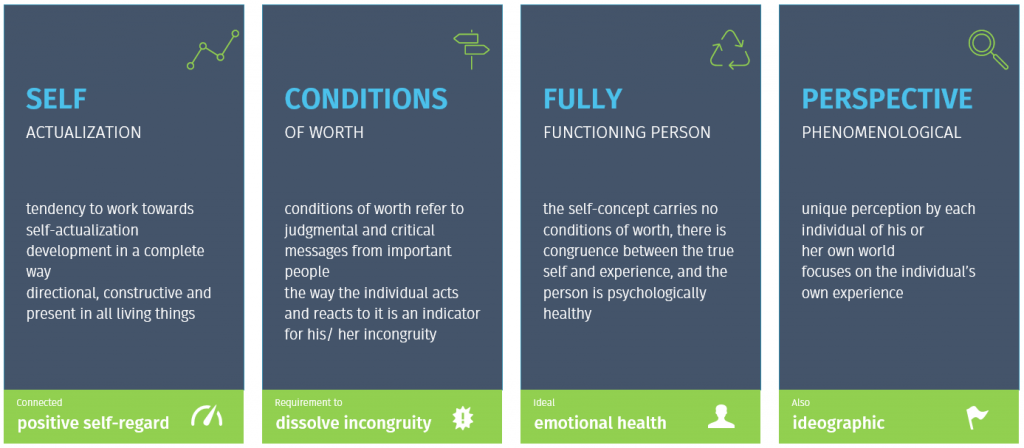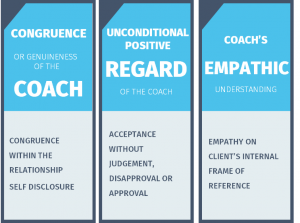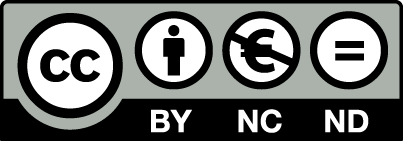Non-directive Coaching
The competence to apply the non-directive, client-centred conversation is achieved by internalising the humanistic personality image of Carl Rogers and the related values. We can apply the values to our own personality as coaches and shape the coach-client relationship based on empathy, (unconditional) positive regard and congruence. The coach-client relationship is fundamentally important in the context of the humanistic approach. After a consistent practice in conversation technique, we are in a position to help the client getting the bottom of his own problems, developing his own solutions and implementing these solutions.
When business managers tell an employee something, only 10% of people are likely to recall it correctly after 3 months. If they give non-directive coaching, that number goes up to 95%!
Source: The Power of Non-Directive Coaching, Lauren Buys, Human Capital Review.
Video-Link: https://www.youtube.com/watch?v=QyXNTZCDtn8
The non-directive counselling or therapy focusses the following 5 aspects
- It is a humanistic approach and major concept is that people are generally trustworthy, resourceful, capable of self-understanding and self-direction, able to make constructive changes, and able to live effective and productive lives.
- The person-centred approach focuses on the client being able to develop a greater understanding of self in an environment, self-exploration and improved self-concepts
- Self-exploration in this context means looking at your own thoughts, feelings, behaviours and motivations and asking why. It is looking for the roots of who we are — answers to all the questions we have about ourselves
- For a successful coaching process, it also focusses the quality of the coach, who needs ability of emphatic understanding in a non-judgement way. The coach does not offer advices, directions and interventions. It is important to be clear that, in its purest form, the lack of direction applies both to the content of the conversation and also to the scope of the conversation.
- Which leads both, the coach and the client, to a relationship, that allows the client to resolve problems and helps the client to be able to make changes for themselves.
- All that bases on client’s responsibility for his life.
As we know from the theory of personality the humanistic influenced non directive or client centred way has several key concepts. Most important are the following:

Carl Rogers stated six sufficient conditions that are necessary for a change
- Coach–client contact: a relationship between client and coach must exist and it must be a relationship, in which each person’s perception of the other is important.
- Client’s incongruence: incongruence exists between the client’s experience and awareness or in other words, between real self and ideal self.
- Coach’s congruence: the coach is congruent within the therapeutic relationship. The coach is deeply involved him or herself — they are not “acting”—and they can draw on their own experiences to facilitate the relationship.
- Coach’s unconditional positive regard: the therapist accepts the client unconditionally, without judgment, disapproval or approval. This facilitates increased self-regard in the client, as they can begin to become aware of experiences in which others distorted their view of self-worth.
- Coach’s empathic understanding: the coach experiences an empathic understanding of the client’s internal frame of reference. Accurate empathy on the part of the coach helps the client believe the coach’s unconditional affection for them.

- Client perception: the client perceives, to at least a minimal degree, the coach’s unconditional positive regard and empathic understanding.
Three of these conditions have become known as the ‘Core Conditions’
Rogers asserted that the most important factor in successful coaching is the relational climate created by the coach’s attitude to their client. He specified three interrelated core conditions.
Let us have a look on the distinction of direct and non-direct approach and the items:
| non-directive | directive |
|
|
Non-directive coaching has a strong focus on helping people to overcome self-limiting attitudes and assumptions. It does this by questioning those attitudes and assumptions in the context of practical problem-solving.
Without dwelling on why the client has made the assumption, non-directive coaching helps the client to recognise it as an assumption (rather than a fact) and see beyond it. Showing a person that they are capable of problem-solving provides concrete evidence of their capacity to explore and develop.
The kind of help is reflected in techniques of non-directive coaching. Techniques among others are e.g.:
Attentive / Active Listening
- coach gains understanding by close attention
- put aside any agendas
- giving the client time and acknowledging their feelings
Purposeful, non-directive, non-judgemental questioning
- focuses closely on what client needs to do, how and when they are going to do it
- helps the client by giving them the opportunity to talk
Constructive challenge
- supports the client to move forward
- range from identify more options to refocussing on the objective
- develop awareness on the client’s own terms
Confidence building reassurance & affirmation
- coach offers reassurance, explicitly stating
- coach points out client’s progress and helps to connect it to their own efforts
Motivational interviewing
- Engaging – used to involve the client in talking about issues, concerns and hopes, and to establish a trusting relationship with a counsellor.
- Focusing – used to narrow the conversation to habits or patterns that clients want to change.
- Evoking – used to elicit client motivation for change by increasing clients’ sense of the importance of change, their confidence about change, and their readiness to change.
- Planning – used to develop the practical steps clients want to use to implement the changes they desire.
Source: https://en.wikipedia.org/wiki/Carl_Rogers
This work is licensed under a Creative Commons Attribution-ShareAlike 4.0 International License
![]()
Summary
In non-directive coaching, the individual or group is the expert and they set the agenda. The coach helps them to think through that agenda and then apply their own expertise to achieve the outcomes they want.
Non-directive coaching is facilitative. It is based on reflective learning and structured problem solving. The coach requires knowledge only of how to help people learn and problem-solve for themselves.
WHY IS NON-DIRECTIVENESS A KEY SKILL FOR A COACH TO CULTIVATE? Because along with non-judgementalism, it’s the backdrop supporting a coaching approach which genuinely embraces clients as experts in their own issues – albeit experts who currently aren’t quite in touch with all the relevant information and insights to help them on their way.
Coaching focuses on the client, the client’s needs, and the client’s agenda. A non-directive approach means coaches refrain from instructing or ‘telling’, asking leading questions which fish around for particular answers, or harbouring frustration that clients may seemingly ‘refuse’ to see or follow what to the coach are obvious solutions. A non-directive approach puts into practice the coaching maxim that “the client knows best how to deal with his or her issue.”
Non-directiveness relies on the coach standing back from his or her own preconceptions. Through deep listening, effective questioning in the moment, and providing a safe confidential space within which the client can imagine and experiment, a coach can facilitate the process whereby client come to terms with and move beyond self-limiting beliefs and/or fears.
Transformative coaching has non-directiveness at its core because only the client can find the key to opening the doors through which transformation comes in her or his particular case. The coach’s role is to observe, reflect back, and provide the mirror via which the client can see and recognise the keys that are necessary for his or her own transformational change and development.
There are numerous good reasons for coaches to build awareness of when they’re in non-directive mode and when they aren’t. Here are 2 to think about.
The coach who doesn’t coach
Most coaches know that excellent coaching is for the most part non-directive, but it’s not that easy for individuals whose strengths lie at the more directive end of the coaching skill spectrum to recognise in the moment when they inappropriately slip into ‘telling’ or ‘advising’ mode. This is especially problematic for those whose professional background or current ‘day job’ is in HR or Learning & Development. So much of their time has been or still is spent solving the problems of others, instructing in rules and regulations, or telling people what to do. Whilst their contribution of insight might be invaluable if requested in a mentoring relationship, for the most part it is highly detrimental in the context of coaching.
The result is that clients may be forced to revert to learning from someone else, being deprived of the opportunity to be facilitated in exploring how to move forward in their own time and in their own way. For under-confident ‘people pleasing’ clients, it can even lead to reliance on the coach. Establishing a reflective practice is key to helping coaches recognise the patterns of thought and behaviour which result in reversion to ‘directive mode’, and to starting the process of strategizing how to avoid them.
The coach who doesn’t challenge
Whilst coaching focuses on the client and the client’s ability to dig deep to find solutions to his or her issues, the coach must be able to fulfil the role of facilitator, mirror and challenger when necessary. Coaching sessions should be far more than cosy chats between friends. Long-suppressed difficult emotions such as anger, grief or frustration might need to be countenanced, expressed and transitioned through, and that means the coach should be capable of being detached enough not to be pulled into over-identification with the client’s situation (collusion) or repulsed by what he or she is experiencing in the moment as the client journeys through the challenging time.
Challenge is seldom pleasant. Yet challenge is often essential in a coaching relationship – coach challenging client, and client challenging coach if need be. This is where the coach needs strong interpersonal and communication skills capable of building sufficient rapport and trust with the client to withstand what can become stormy seas. Having the sensitivity and ability to read the whole person is essential for a coach when choosing less or more directive modes of interaction in the moment. Challenge should not be feared. It should be prepared for by building sharp awareness of exactly how directive or otherwise one is or needs to be in the moment, as well as sufficient flexibility to move from one mode to another as and when necessary.
Material on this blog is Copyright Dr Alison Newby, and is licensed under a Creative Commons Attribution-NonCommercial-NoDerivatives 4.0 International License.

GROW model in non-directive coaching
GROW stands for Goal, Reality, Options and Wrap-up. (In some versions, the O also stands for Obstacles and the W for Way forward or Will.)
Developed in the UK in the 1980s, the GROW model is a loosely sequential, problem-solving model. It focuses on building confidence and raising awareness (including self-awareness) in order to enable the client to take full personal responsibility for their own learning and development. The model is intended to be used flexibly and iteratively, across and within sessions. For example, reflection on the outcomes of an action might lead the client to adjust their goal.

source: https://en.wikipedia.org/wiki/GROW_model
This work is licensed under a Creative Commons Attribution-ShareAlike 4.0 International License
![]()
Quote: Citizens’ Curriculum guide to Non-directive coaching, Learning and Work Institute 2017 – useful questions for non-directive coaching
- What makes you say that? | What do you mean?
- How do you feel about that?
- Can you tell me more, to help me understand?
- What is the real issue here? | Why is that important to you?
- What might be [person X’s] reason for doing that? | What would [person X] say if they were here now? Is there any justification for what [person X] said/did?
- What makes you so sure about that? | Have you asked them? | What if you’re wrong?
- Is that connected to anything?
- What else? [This is one of the most useful coaching questions. Use it to encourage/challenge the client to dig deeper, e.g. to think more about an issue or to come up with more ideas.]
- How will that help?
- What might be a problem? | What makes that a problem? | What can you do about that?
- What’s the worst that could happen?
- What will you need to do? [Follow up with e.g. What other things could you do?]
- What do you think you should do first/next/after that? | What might you need to do before that?
- When will you do it? | How long will that take?
- Is that realistic? [Another very important question! Follow up with e.g. What makes you say/think that?]
- Are you 100% sure you will do that? Why not 100% sure? [This question is about how much the client is willing to commit to doing what they say they intend to do – i.e. it is about taking responsibility.]
- Last week you told me… What happened? | How did it go? Why?
- What stopped you from doing more?
- Can you think of a time in the past when you had a problem like this? How did you solve it?
- Does your goal/plan still make sense to you? | Do you need to think about your goal/plan again?
- What could I do to support you?
- Is there anything else you want to talk about now or are we finished?
Source: Citizens’ Curriculum guide to Non-directive coaching, www.learningandwork.org.uk
Exercise it!
To get more familiar with non-directive interviewing you can use this exercise sheet
 The European Commission support for the production of this publication does not constitute an endorsement of the contents which reflects the views only of the authors, and the Commission cannot be held responsible for any use which may be made of the information contained therein.
The European Commission support for the production of this publication does not constitute an endorsement of the contents which reflects the views only of the authors, and the Commission cannot be held responsible for any use which may be made of the information contained therein.
